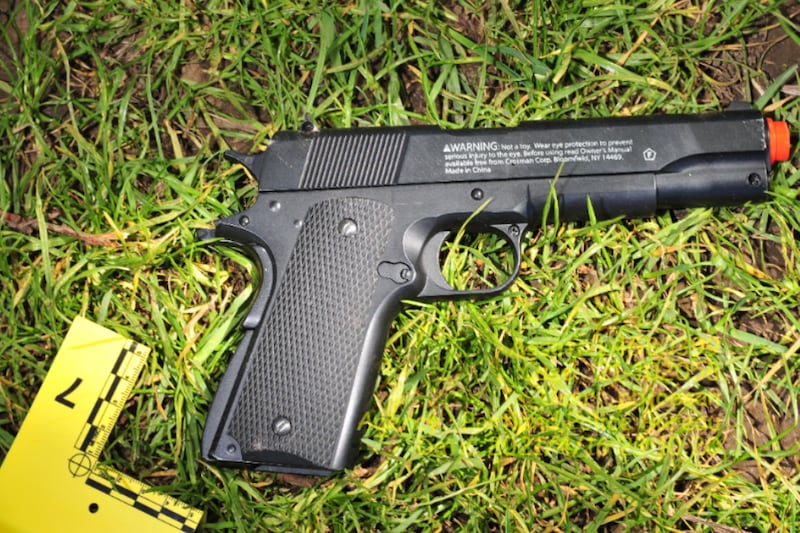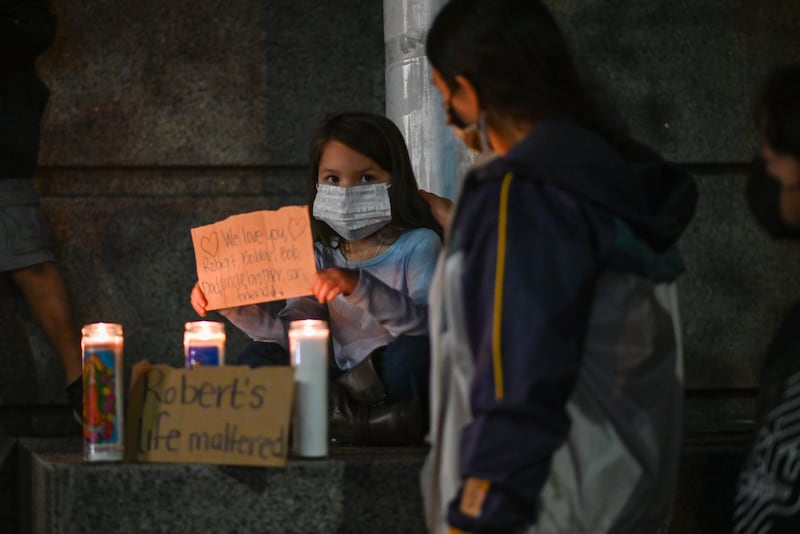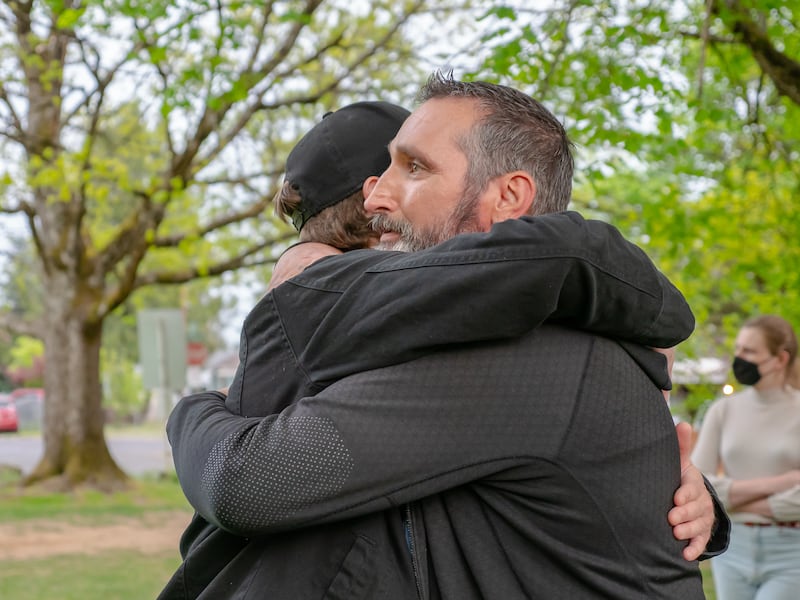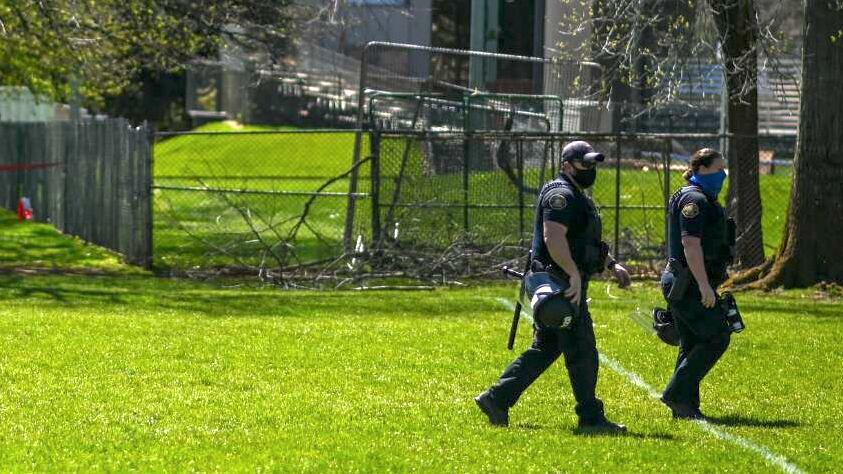In September, a Multnomah County grand jury declined to indict Portland Police Officer Zachary DeLong for the shooting death of Robert Delgado. Last Friday, the Multnomah County District Attorney’s Office released nearly 800 pages of transcripts from the proceedings.
In those pages are answers to questions that have lingered since the April 16 fatal shooting in Lents Park.
The testimony illuminates the perspective of DeLong as he shouted orders at Delgado from approximately 90 feet away, in an exchange that would turn deadly within four minutes.
It also shows the thinking of other officers and bystanders who witnessed the exchange devolve rapidly, and who heard the “pop, pop” from DeLong’s AR-15 rifle at about the same moment that Officer Samantha Wuthrich fired a round from DeLong’s less lethal munition launcher.
The shooting was exactly the kind of scenario that city officials had spent years trying to prevent: a Portland police officer killing a distressed, unhoused man with a history of mental illness. Police believed Delgado was armed with a real gun only to discover post-mortem that it was a replica.
The documents contain the information that the DA’s office and the Oregon Department of Justice jointly presented to grand jurors, who found no criminal wrongdoing by DeLong on the third day of the proceedings, Sept. 23.
The transcripts also show in granular detail the pivotal minutes that led to Delgado’s death. The pages detail five turning points that escalated a potentially benign incident into a fatality.
1. The initial 911 caller told dispatch he wasn’t certain whether the gun was real or a replica.
On the morning of April 16, Chase Hagan was on a walk with his fiancée and their dog in Lents Park when they noticed a man quick-drawing a gun. Hagan called the city’s nonemergency line. (The city’s Bureau of Emergency Communications confirms to WW that Hagan had also called the night before, at 11:47 pm, to report an “unwanted person” camping in Lents Park.)
In the call audio from April 16, obtained by WW through a public records request, Hagan tells the call taker he isn’t certain the gun is real.
“Hi there. I have a guy in Lents Park who kind of thinks he must be some kind of cowboy,” Hagan told the BOEC call taker at 9:28 am. “He’s wielding what looks to be a firearm. I’m too far away to tell whether or not it’s an actual gun or an airsoft gun.”
BOEC dispatched DeLong, who then called Hagan back to gather more information. The call between DeLong and Hagan was not recorded, but Hagan testified that he relayed his uncertainty about the gun to the officer.
“To my best recollection, I said the same thing,” Hagan recalls, “where it appeared to be a firearm. I wasn’t sure if it was. I wasn’t sure if it was a toy weapon.”
It’s common sense for police to assume a weapon is real when a subject is wielding one, especially in public. And because DeLong never got closer than 90 feet from Delgado, it would have been nearly impossible to see the gun’s orange tip from that distance.
But it does not appear the Police Bureau made any effort to ascertain the gun’s authenticity, even after Hagan expressed his uncertainty. The bureau did not respond to WW’s request for comment on the matter.
Read our cover story from May: Last Month, a Portland Cop Killed a Man Who Had a Replica Gun. That’s Part of a Pattern.

2. Neither BOEC nor PPB coded the call as mental health related.
DeLong is one of 146 Portland police officers who have undergone 40 hours of specialized Enhanced Crisis Intervention Training to deescalate crisis situations. He’s also one of 168 PPB officers certified to carry an AR-15 rifle.
Despite his enhanced crisis training, DeLong testified he did not believe Delgado was experiencing a mental health crisis.
“Working this district where there’s a lot of houseless people who suffer from mental health issues…it’s always in the back of my mind,” DeLong testified. “But based on his actions, when I see him, there’s nothing that’s making me think that he’s in crisis or something along those lines.”
Later, he added that Delgado appeared to be under the influence of stimulants.
“To see somebody go from zero to 100,” DeLong testified, “from just nothing to completely enraged like this, what I’m thinking at this point is drugs, meth, some sort of stimulant. Something has got him spun up.”
None of the law enforcement agencies responding that morning thought otherwise.
WW obtained the computer-aided dispatch record from the incident, which shows neither the city’s Bureau of Emergency Communications nor the Police Bureau coded the call as mental health related.
As WW reported in May, BOEC call takers are trained to flag a call as mental health related if the 911 caller describes what sounds like a potential mental health crisis. That way, the bureau can send an ECIT response and employ its deescalation techniques.
BOEC spokesman Dan Douthit says police officers have a responsibility to adjust how they categorize a call based on what they see when they arrive. “The onus is on both [the] call taker and responding officer to ensure the correct call type is entered into CAD,” he tells WW.
None of the responding police officers flagged the call as mental health related in their mobile data computers, Douthit says. PPB did not respond to WW’s request for comment on why its officers didn’t flag the call.
Related: How Portland Police Came to Be Armed With Military-Grade Rifles and What Happened as a Result.
3. Police issued conflicting commands to Delgado.
DeLong testified that he yelled multiple commands at Delgado, including this life-or-death warning: “Listen, man, if you reach for a gun, I’m going to fucking shoot you.”
But review of eyewitness testimony paints a picture of a chaotic scene in which police commands were contradictory—and Delgado, who at one point appeared to comply, grew agitated.
For instance, video from the shooting shows DeLong yell at Delgado to “lay down on the ground now” and then, in the same breath, to “put your hands up, dude.” Immediately afterward, Officer Wuthrich also tells Delgado to put his hands up, followed by another command from DeLong to do the same.
Delgado then repeats the cops’ commands back to them: “Get your hands up,” he says. This moment in the video caught grand jurors’ attention.
“Right there. He’s right there,” a juror says, referring to Delgado. “And his hands are up.”
PPB homicide Detective Anthony Merrill, who testified as the video played, concurred with the juror: Delgado was walking away, with his hands raised and empty at that moment.
“And he’s walking away from the—” Merrill says.
“And he’s walking away,” a juror says, finishing Merrill’s sentence.
“Yeah,” Merrill responds.
“And there doesn’t seem to be anything in his hand,” a juror added.
“I didn’t see anything in his hand at that point, no,” Merrill says.
Wuthrich, conversely, testified that Delgado repeatedly raised his hands instead of complying with DeLong’s commands to lie on the ground.
“[DeLong] continued to tell him to get on the ground: ‘We believe you have a gun. Get on the ground,’” she said. “And the subject just continued to throw his hands in the air.”
Officer Ken Le, also in the park, testified that he too shouted commands at Delgado from behind a police vehicle.
“And then, because I don’t want to have too many people screaming, I stopped the commands,” Le recalled. “That way he can focus on Officer DeLong and Wuthrich.”
Le described seeing Delgado crouch down, then quickly pivot toward DeLong and Wuthrich, pointing a black handgun in their direction.
The next thing Le remembered was hearing the shot from a rifle, he testified, and seeing Delgado fall to the ground.

4. Delgado pointed the replica gun at police seconds before they shot him.
Eyewitnesses testified that Delgado pointed the replica gun directly at DeLong and Wuthrich in the seconds before they fired at him. No one’s testimony contradicted this claim.
DeLong testified he saw Delgado rummage through his belongings and, within seconds, he was “staring down the barrel of a gun”—Delgado’s gun, which police later confirmed was a replica.
“How’d that make you feel?” DOJ assistant attorney general Kurt Miller asked.
“I thought, I’m going to get fucking shot,” DeLong said. “It scared the shit out of me.…I just remember thinking, oh boy.”
5. Cops fired a less lethal weapon and an AR-15 nearly simultaneously.
Wuthrich said the original plan was to fire a less lethal munition at Delgado if he advanced toward her and DeLong. “He kept walking towards us with his fists balled, yelling at us,” Wuthrich said. “And so I believed that a 40-millimeter would be better at that point when I did not think that there was a handgun in play.”
But that went out the window, she testified, when Delgado stood with his feet shoulder width apart in a “triangle stance” and pointed what looked like a real handgun directly at them.
“I braced for impact,” Wuthrich said. She then fired DeLong’s 40 mm launcher, which she had retrieved from his patrol vehicle, at Delgado.
“After I shot my 40, he immediately fell to the ground,” Wuthrich said.
“Did you have a sense of what caused that?” deputy DA Todd Jackson asked.
“I would guess it was Officer DeLong’s shot,” Wuthrich said. “We both fired at the exact same time.”
Investigators later recovered two shell casings from DeLong’s rifle, and two spent less lethal munitions: one from the 40 mm launcher Wuthrich fired, and another from Officer Cameron Smith, who fired the projectile at Delgado once he was already shot and down on the ground.
Oregon State Police Medical Examiner Sean Hurst determined Delgado died from a gunshot wound to his torso.
DeLong, whose AR-15 was equipped with a “holographic sight,” according to PPB’s death investigation report, said he fired two rounds “as quickly as I could.” Delgado’s decision to point the gun startled DeLong, he said, and he reacted to save himself and Wuthrich.
He then cited a commonly used, but controversial, theory of policing to justify firing at an armed subject without pausing to assess, called the action-reaction model.
“There’s just no way to be ready for it,” DeLong said. “It’s just how the human brain works, I guess. You just can’t keep up. You’re always behind the curve when you’re reacting.”
Near the end of the final day of proceedings, Miller asked DeLong—who said he grew up less than a mile from Lents Park—if, in retrospect, he would have done anything differently.
“It’s difficult to describe, you know, in hindsight, but I don’t think so. This is my neighborhood,” DeLong said. “I love the neighborhood and I just feel, like, accountable to the people that live there to go and check on this guy, to go to this call. I think I would be negligent, derelict if I didn’t.”


